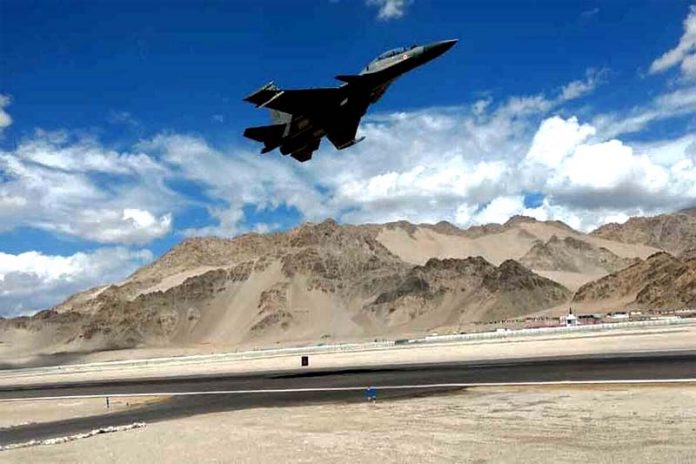India’s ongoing development of its highest airfield at Mudh in Nyoma subdivision, at a remarkable altitude of 13,700 feet, symbolises both a technical marvel and a strategic asset, reflecting the nation’s commitment to securing its borders and enhancing its regional defence capabilities. Located just 35 kilometres from the Line of Actual Control with China in Eastern Ladakh, this airfield project highlights India’s serious response to regional dynamics and the importance of bolstering infrastructure in sensitive border areas. With the runway already prepared for emergency landings and full operational capabilities expected next year, Nyoma Airfield represents a critical step in India’s mission to enhance rapid deployment, preparedness, and logistical support in Ladakh.
The new airport, set to become India’s highest operational airfield, is also a testament to the military’s resolve in defending India’s northern frontiers. At a time of increasing regional tensions, particularly in the context of recurring standoffs along the LAC, the Mudh-Nyoma airfield will enhance India’s capacity to respond swiftly to threats, ensuring a permanent footprint in Eastern Ladakh. The airfield’s proximity to the LAC allows for quicker troop deployments and faster delivery of supplies, underscoring India’s intentions to safeguard its borders while sending a clear message of deterrence. In recent years, the geopolitical stakes in the region have only intensified, and infrastructure developments such as Nyoma Airfield enhance India’s strategic positioning in these contested terrains.
Constructing a high-altitude airfield comes with inherent challenges. With minimum temperatures dropping to -35 degrees Celsius in winter, Nyoma is one of the most inhospitable places for a project of this scale. Additionally, the rarefied atmosphere at such elevations significantly impacts both machinery and human endurance, as operations demand continuous acclimatisation and specialised equipment. The near-completion of the 3-kilometre runway, which is 95 percent finished, stands as a testament to the Border Roads Task Force’s resilience and capability under such challenging conditions.
Spearheading this project is Colonel Ponung Doming, a trailblazer female officer from Arunachal Pradesh, who exemplifies the determination required to see through the construction of this monumental project. Equally impressive is the involvement of KCC Build Con Pvt Limited, the private contractor responsible for building this high-altitude airstrip. At an estimated cost of Rs 218 crores, the airfield is a significant investment in India’s defence infrastructure, with KCC and Project Himank engaging hundreds of workers to sustain construction efforts even in the extreme conditions of Ladakh’s unforgiving climate.
For decades, Leh’s Kushok Bakula Rimpochee Airport, 200 kilometres away from Mudh, was the primary operational airbase for both military and civilian flights, requiring the transport of heavy military equipment by road to the border. This airfield will minimise logistical challenges and reduce response times for defence deployments, potentially serving as a launchpad for all types of defence aircraft once completed. The airfield also opens doors to improved civilian infrastructure, facilitating potential economic growth and accessibility for local populations in Nyoma and nearby regions. This development aligns with India’s broader goal of enhancing connectivity and infrastructure in border states, promoting growth in remote areas often overlooked in development agendas. Moreover, Nyoma Airfield will be a strategic advantage in an environment where high-altitude preparedness is critical for effective defence. In light of infrastructure developments on the other side of the border, India needs to keep pace. Enhanced air connectivity in Eastern Ladakh is likely to have a deterrent effect on any possible aggression, reaffirming India’s resolve to maintain security along its borders.
This development also reflects India’s progress towards self-reliance in defence infrastructure. In recent years, India has actively focused on enhancing defence capabilities by investing in indigenous technologies, constructing border infrastructure, and augmenting high-altitude military preparedness. The construction of this airfield is a symbol of India’s unwavering resolve to defend its sovereignty and strengthen its infrastructure in even the most challenging environments. Nyoma Airfield is more than just a strategic asset; it is a beacon of national pride and resilience.
Trending Now
E-Paper


